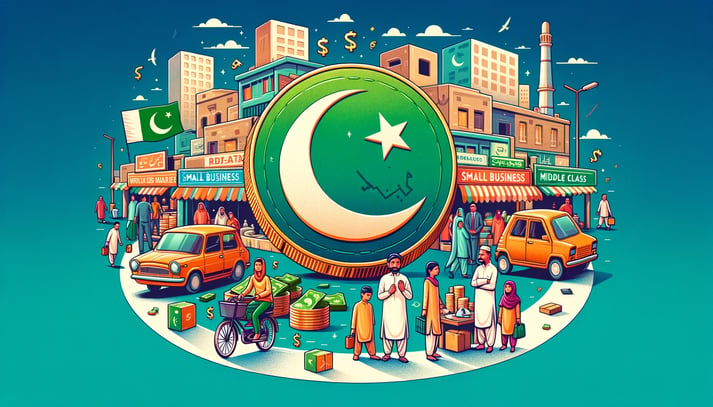Shrinking Middle Class in Pakistan: Challenges and Outlook
Discover the causes and effects of Pakistan's shrinking middle class, from high inflation and economic stagnation to rising living costs, and the uncertain future ahead.
LIFEREADING LIST
shepherd@techtravelerdiary.com
6/4/20243 min read


Pakistan's middle class has been declining due to high inflation, economic stagnation, and rising costs of living. Estimates suggest the middle class, traditionally around 35% of the population, has shrunk significantly since 2019. Factors like slow GDP growth, 30% inflation, and diminishing purchasing power have squeezed the middle class.The outlook for the next three years remains challenging, with continued economic pressures expected. However, opportunities exist in sectors like education and healthcare to support middle class growth.This blog post examines the causes behind the shrinking middle class in Pakistan and provides an outlook for the coming years. It aims to inform readers about the economic realities facing the middle class and the factors shaping their prospects.
Shrinking Middle Class in Pakistan: Challenges and Outlook
The Middle Class in Pakistan: A Shift in Numbers and Outlook
The concept of class has many dimensions, including economic, political, and cultural. In Pakistan, the middle class has been a significant segment of the population, with estimates suggesting it comprises around 35% of the total population. However, recent trends indicate a decline in the size of the middle class, with factors such as high inflation, economic stagnation, and rising costs of living contributing to this shift.
Historical Context
Historically, the middle class in Pakistan has been growing rapidly, with an average annual growth rate of 16.2% between 1999 and 2018[1][3]. This growth was driven by factors such as increased educational attainment, urbanization, and a growing service sector. The middle class was seen as a key driver of economic growth, with higher consumption and investment contributing to overall economic development.
Recent Trends
However, in the last three years, the situation has changed. Estimates suggest that the middle class has been "wiped out" due to high inflation, unemployment, and economic stagnation[2][4]. The World Bank estimates that Pakistan's real GDP contracted by 0.6% in 2023, with inflation hovering around 30%[1]. This has led to a decline in the purchasing power of the middle class, making it difficult for them to maintain their standard of living.
Factors Responsible
Several factors have contributed to this decline in the middle class:
1. High Inflation: Inflation has been a major challenge for the middle class, with prices of essential goods and services rising rapidly. This has reduced the purchasing power of the middle class, making it difficult for them to maintain their standard of living[4].
2. Economic Stagnation: The economy has been experiencing slow growth, with the World Bank estimating a contraction in real GDP in 2023[1]. This has reduced the opportunities for employment and income growth, leading to a decline in the middle class.
3. Rising Costs of Living: The cost of living has been increasing rapidly, with prices of housing, food, and other essential goods and services rising. This has put pressure on the middle class, making it difficult for them to maintain their standard of living[5].
Outlook for the Next Three Years
The outlook for the middle class in Pakistan for the next three years is challenging. The economy is expected to continue experiencing slow growth, with high inflation and rising costs of living remaining major challenges. The government's policies, including the removal of lower income groups from the tax net, suggest that the middle class is now defined at a higher income level than in the past[4].
Conclusion
In conclusion, the middle class in Pakistan has been declining in recent years due to high inflation, economic stagnation, and rising costs of living. The outlook for the next three years is challenging, with the economy expected to continue experiencing slow growth and high inflation. However, there are also opportunities for growth and development, particularly in sectors such as education and healthcare.
Citations:
[1] https://file.pide.org.pk/pdf/Working%20Paper/Middle_Class_Nayab.pdf
[2] https://www.dawn.com/news/1371675
[3] https://file.pide.org.pk/pdfpideresearch/wp-0077-estimating-the-middle-class-in-Pakistan.pdf
[4] https://criterion-quarterly.com/middle-class-empowerment/
[5] https://www.brecorder.com/news/4549367
[6] https://profit.pakistantoday.com.pk/2020/09/19/how-big-is-the-pakistani-middle-class/
[7] https://www.dawn.com/news/1715472
[8] https://www.worldbank.org/en/country/pakistan/overview
[9] https://www.finance.gov.pk/survey/chapter_23/Highlights.pdf
[11] https://www.thenews.com.pk/print/895384-middle-class-increasingly-squeezed-in-recent-years
Embark on a journey of innovation and exploration with us.
Connect
Subscribe
shepherd@techtravelerdiary.com
© 2024. All rights reserved.
